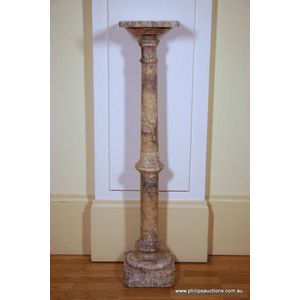Victorian Alabaster Pedestal with Spiral Stem
You must be a subscriber, and be logged in to view price and dealer details.
Subscribe Now to view actual auction price for this item
When you subscribe, you have the option of setting the currency in which to display prices to $Au, $US, $NZ or Stg.
- Alabaster - Alabaster is soft natural stone used for statuary, with a similar appearance to marble, but easier to work with. As it is softer than marble, an item made from alabaster can be scratched with a metal object, and an alabaster item does not polish to a high surface gloss like marble.
Alabaster objects can be semi-translucent. Alabaster occurs in a pure white form and also with veining from dirt. Colours vary from white through yellow and pink to brown. The veining is usually green or black but can be multicoloured.
Being semi-translucent, alabaster is often used for the bowls of figural lamps, with the figure itself being either alabaster or marble. - Victorian Period - The Victorian period of furniture and decorative arts design covers the reign of Queen Victoria from 1837 to 1901. There was not one dominant style of furniture in the Victorian period. Designers used and modified many historical styles such as Gothic, Tudor, Elizabethan, English Rococo, Neoclassical and others, although use of some styles, such as English Rococo and Gothic tended to dominate the furniture manufacture of the period.
The Victorian period was preceded by the Regency and William IV periods, and followed by the Edwardian period, named for Edward VII (1841 ? 1910) who was King of the United Kingdom and the British Dominions and Emperor of India for the brief period from 1901 until his death in 1910. - Plinth - The square or rectangular base of a piece of cabinet furniture, often ornamented with moulding. The plinth may be separate, as in some wardrobes or presses, and act as the support for the carcase. In a false plinth, the moulded boards may be attached directly to the piece. Furniture with a plinth base usually does not have separate feet. The term derives from architecture where it denotes the base of a column or statue.
This item has been included into following indexes:
Visually similar items

A Victorian marble pedestal, later 19th century, the white marble pedestal with grey striations, having a square top with canted corners, the barley twist stem of tapering form with gadrooned knops and knobbed bands and raised upon a stepped socle to an oc

A Victorian marble pedestal, second half 19th century, the pedestal in lightly veined and flecked white marble with a spiral stem and a lobed knop to a stepped socle and faceted base. Height 83 cm.

An alabaster pedestal, in richly mottled and veined pale, amber and grey alabaster, with a square top to a graduated circular shallow cup, a knopped stem tapering to a shaped, waisted and spreading socle upon a squared base with canted corners. Height 114

A marble pedestal, in mottled amber tones with black veins, and of simple lines with a square top, a cylindrical column with a single band to the top and bottom, and raised on a stepped rectangular base. Height 112 cm
